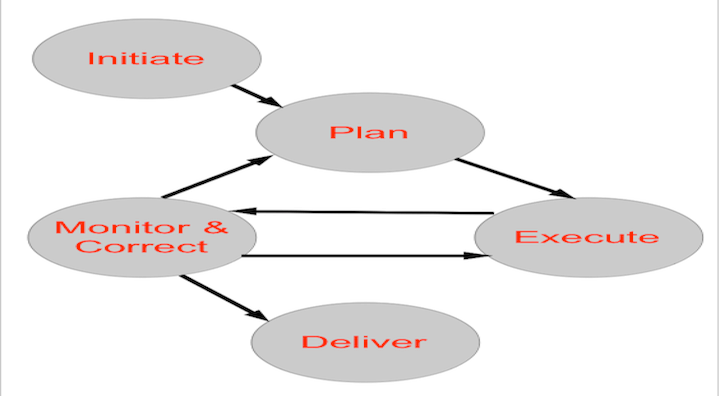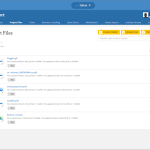I have been a project manager for the past 20 years, have worked on small and large projects involving software, hardware, mechanical, manufacturing, logistic & service teams working together to bring products to the market. What I have learned working on hundreds of projects is that there is a blue print for practicing good project management! Education in project management helps, there are many good books & curses that you can take advantage of, but nothing beats hands on experience and learning from your and other Project Managers’ successes and more importantly your mistakes. If you are new in project management or want to brush up your knowledge about best practices project management can follow , this article is for you.
What are Best Practices Project Management can follow?
Projects regardless of how big or small they are have 5 phases (Note: the official name for this in PMBOK is “process group”, If you are taking PMP exam make sure to use process group instead) understanding these phases and adhering to them goes a long way in helping you to deliver successful products. By successful I mean products that you will ship to market on time, on budget while meeting the original specification. These phases are best practices project management should follow:
- Initiate
- Plan
- Execute
- Monitor & correct
- Deliver
1-Initiate
This is the second most exciting time in the life of a project, Delivering the product being the most existing one. A new project is conceived and everybody is in elated to work on a brand new product. This is the time to put the foundation of the project right. In this phase you need to define the following:
- Project scope– The work that needs to be accomplished to deliver the product or service
- Project objectives-what the project will accomplish, what is the end result that will be delivered to the customer
- Project constraints and assumptions– Cost, time frame, resources & specifics like your company requires you to use a specific part made by your company in the new product
- Project organization rules and responsibilities– Create the project matrix of who does what, with clear definition of responsibilities
- Project stakeholders- Who is the customer, who is the product owner, who is the project manager and so on
- Project statement– Some call this project charter. This is a short document describing the scope, objectives, and participants in a project.
2-Plan
This is where the hard works begin, You need to carefully plan every detail in the project to make sure the project will finish successfully on time and budget. I am a big fan of Work Breakdown Structure or WBS, it is the best tool to make sense of complex projects and tasks. If you are not familiar with WBS, there are several good books and online articles about this subject. In this phase you need to define the following
- Statement of work– The specification for product & service
- Work Breakdown Structure– Break each task to several smaller tasks and keep doing the same on smaller tasks (called subtasks) until you have well defined and understood task that could be easily estimated
- Schedule– A detailed task list. This may get modified or enhanced during execution phase. Gantt chart is a great tool to view a project’s details graphically in time
- Budget– The project budget for salaries, equipments, consumables or anything else needed in the project
- Baseline plan– Your hope for how project will look like when you finish, this is a snap shot of schedule at a given time. You will use this to compare your progress against actual schedule
- Risk– Define all risks to the project that might effect negatively the project in terms of successful development, time to market and budget
- Resources– Who do you need for the project, how many people and when
- Change Plan– How changes in scope and requirements in incorporated in the project
- Customer Approval– Define what the customer is expecting at the time or delivery
3- Execute
This is where the actual work on product delivery happens. A big portion of project time is spent in this phase. The success of product development & delivery depends on the quality of your workforce plus correct planning and flawless execution. I can’t emphasis enough the importance of your team members experience and knowledge in the outcome of the project. In this phase you need to define the following:
- Team– For each discipline in your project create a list of people needed to carry out the portion of the product
- Product Development– Short milestones with clear output / outcome. Weekly or at most monthly milestones should be used
- Quality Assurance– How to check the output of each milestone. Matrix and spec for defining success
- Status reporting– This is part of communication plan and defines what you need to be reported and when. Ask everybody in the team to write a short daily status report describing what they accomplished that day, what they plan to do tomorrow and if they face need help with a challenging issue. Make sure the status report is visible in real time to all team members. This reduces the need for constant meetings. Keep meeting short and standing room only (no chairs)
- Approvals-The process for approval of each milestone (who, how & when) including final product delivery
4-Monitor & Correct
Monitoring the progress of the project is an integral part of the execution of the project. You need to measure, calibrate each milestone and output from product delivery. Based on this monitoring, you may need to take corrective action and this may lead to changes in plan.
- Scope-The process of of verification and how is done
- Quality– What quality is accepted before the project moves to next phase.
- Risk– Have we faced any of the risk factors or any new risk factor has arrived?
- Cost-Tracking the cost and check if it is still aligned with the output of the milestone
- Schedule-Where in the project development are we for each given time? did the milestone was met with both time and cost? How long we need to allocate for corrections if any?
5-Deliver
Congratulation, the product is ready to ship, you have done a great job, but you are not finished yet. You need to review & document what you have done, lessons learned and recommendation for future projects before you close shop. These are the steps you need to take in this phase:
- Validate– All requirements are met and the customer is in agreement
- Product turnover– Hand out the product to product support team. Make sure to document procedures on how to maintain & fix issues
- Review– Have a review on how the project went, any lesson that could be learned, if you could start the project over again what you would have done differently. You have shipped your product to market, now is a good time to learn from success and failures you encountered during the project. Take the time to document them. Human memory is flaky and soon you will forget some very important details about your experience working on the project.
- Archive-Keep all documents, code and blue prints for reference and use by future projects. If your project is online there are tools to archive the project as a whole including tasks, charts, documents and communication between the team.
Following are the best practices project management should follow for a purposeful execution.
Summary
Project management is complicated discipline and requires several skills including leadership capability, attention to details & planning, good communication skill and great interpersonal capabilities. As a project manager you should be a good listener. If you take the time to listen, you will find most of the issues and concerns the team has which might effect the outcome of the project. This way you can take corrective action before the project is in crises. The good news is that there are tools out there that help project managers to navigate the project management challenges better and with more confidence. There is always the question to use desktop or SaaS project management software. Refer to how to choose between desktop and online project management software for guidelines. Binfire helps you to manage projects collaboratively with your team and gives you the tools you need for all phases in project management. To try Binfire, our online project management software visit here.
Cheers,
David Robins









Great article about project management best practices! The 5 phases cover the entire project management spectrum!
Great article about project management best practices! The 5 phases cover the entire project management spectrum!
Great article about project management best practices! The 5 phases cover the entire project management spectrum!
Great article about project management best practices! The 5 phases cover the entire project management spectrum!
Great article about project management best practices! The 5 phases cover the entire project management spectrum!